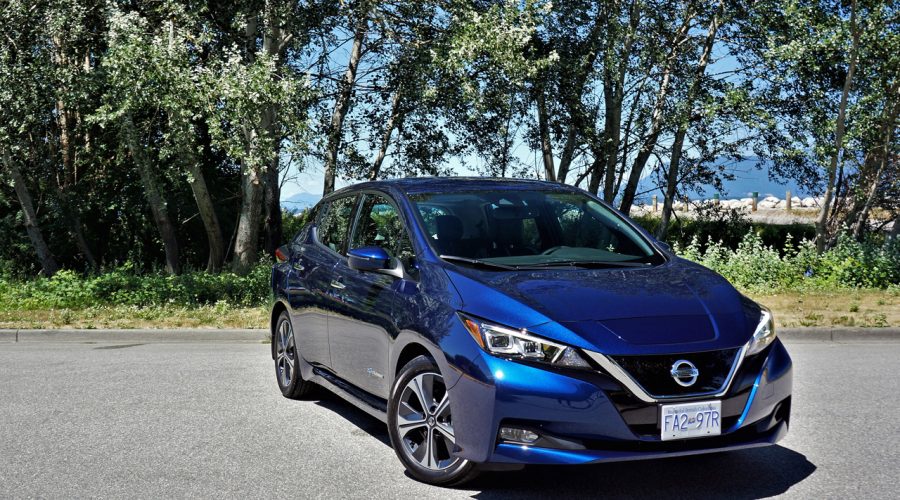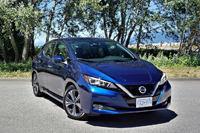
Nissan has taken a very different tack by normalizing its second-generation Leaf, which is both good and a bit of a shame. Don’t mistake me for being negative about its more familial design direction, because the first version’s whacky styling almost made a balloon look square, but much if not all of the initial model’s whimsy is now gone, replaced by a slick, efficient, business-first compact.
I like the look. With the Leaf’s original Dr. Seuss-inspired styling now relegated to EV history, a design that must have fully appealed to the plug-in masses that snapped it up faster than any EV before, a matured interpretation of the monobox design is all crisp, clean creases of trademark V-motion, floating C-pillar, Z-like taillight Nissan goodness, a sharp contrast to the ovoid Leaf of yore.
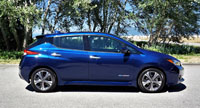
Alas, open the tiny hood just above that new V-shaped grille and the old car’s beautifully detailed metal “engine” cover with blue and chrome “NISSAN zero Emission” branding is gone, replaced by a much more advanced 110kW electric motor topped off with a much less inspiring black plastic cover, the branding now simply stating its “NISSAN” maker.
Yes, the electric vehicle industry is growing up, and with its maturation our once fun and funky Leaf teenager is becoming an older, more responsible adult. This said there’s much good that can be said for a more conservative approach when it comes to car design, especially when factoring in the need for aesthetic longevity, which translates into higher resale values due to greater appeal within the used market.
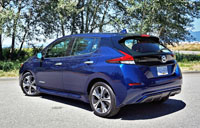
That new 110kW motor may do even more to bolster pre-owned Leaf values than styling, thanks to a lot more get-up-and-go and much greater range. Imperially that number reads 147 horsepower, a 40 hp gain over its predecessor, while torque is up 30 lb-ft to a much more motivating 236.
A more potent 40kWh Li-ion battery now powers the uprated motor, a 16kWh improvement over the previous generation without any increase in physical size. This means it can now travel up to 241 kilometres on a single charge compared to just 172 km for the old model, and this 69-km extension makes all the difference in the world.
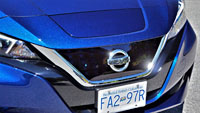
Depending on the length of your commute or the complexity of your errand list, the new Leaf lets you drive around for days without recharging. What’s more, the range anxiety some might have experienced with the outgoing model should be all but gone, as long as you top it up well before the little blue battery graphic shows a need.
Replenishing from near empty takes about seven hours from a 240-volt charger or more than an entire day when hooked up to a regular 120-volt household socket. I recommend you purchase a proper Level 2 charger so you can fill up overnight, or you’ll be making a lot more impromptu stops at retail outlet charging stations than your schedule may allow for. Then again, if you can find a Level 3 DC fast-charging station you’ll be able to fill it from near zero to 80 percent in about 40 minutes, while recharging to 80 percent is always significantly quicker than trying to top it off the final 20 percent, no matter which charging process you’re using.
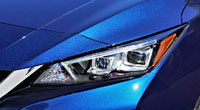
Fortunately, owning a plug-in allows for some front-of-the-line exclusivity when it comes to parking spots. In my city the majority of shopping malls, big box stores, hotels, and government buildings offer free charging for their greenest customers, and more often than not these specialized parking spots are located right next to the front doors of their establishments, providing a level of VIP convenience to EV ownership.
Livability in mind, the Leaf has always been roomy and comfortable. The new one is not noticeably improved for occupants or cargo, with the latter measuring a fairly generous 668 litres (23.6 cubic feet) with the 60/40-split rear seatbacks upright and 849 litres (30.0 cubic feet) when they’re folded. What’s more, there’s no battery awkwardly protruding into the cargo area like some other EVs, with the Leaf SL’s load floor nice and flat other than a smallish Bose Acoustic Wave System boombox butting up against the rear seatbacks, the seven-speaker audio upgrade making the most of the otherwise near silent Leaf interior.
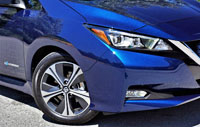
The Leaf cabin is certainly quiet thanks to a lack of engine and exhaust notes, the wind rushing past and the road below the only noticeable aural intrusions, and the latter two variables are kept to a hush thanks to ample sound-deadening insulation, plenty of plush surfaces, and soft-touch composites on the dash-top and door uppers, resulting in a fairly refined environment for this class. Of course, such should be expected of a compact hatchback costing upwards of $36,798 (check out CarCostCanada for all 2019 Nissan Leaf pricing including trims, options, rebate info and even dealer invoice pricing), a seemingly steep price until considering the smaller Chevrolet Bolt starts at a cool $44,400.
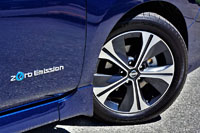
Even with provincial rebates of up to $5,000 in BC and $8,000 in Quebec (Ontario no longer offers a plug-in incentive program), that’s a lot of coin for a vehicle class that normally starts well under $20,000, whereas the Leaf’s second-rung SV trim will set you back $40,698, and the top-line as-tested SL rings in a total of $42,698. Again, that’s chump change compared to the top-tier Bolt’s $49,300, while a similarly sized BMW i3 I recently tested topped $70k.
You can bet that both the BMW and Bolt come fitted with leather seats and plenty more, but so does the Leaf SL. In fact, the SL’s partially perforated leather upholstery was ultra-luxe thanks to a two-tone black and grey design, the latter comprised of the same microfibre-like Bio Suede PET cloth used for the two lower trims’ upholstery, while plenty of blue contrasting thread was joined by the same stitching on the armrests, all complemented with blue accented graphics in the gauge cluster and infotainment touchscreen, not to mention a cool blue glowing gear selector.
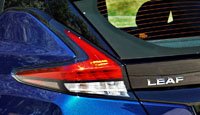
The seats are plenty comfortable too, with decent two-way powered lumbar support that seemed to fit the small of my back quite well, but much to my surprise and disappointment the otherwise beautifully finished leather-wrapped, flat-bottom steering wheel has a standard heatable rim but no telescopic capability, only moving up and down marginally via its tilt feature. This posed a problem when trying to get comfortable and maintain best possible control, as I had to stretch my arms too far to reach the steering wheel rim when the pedals were set up for my admittedly long-legged, short-torso five-foot-eight body.
The rear seating area is fairly roomy, albeit it’s still easy to tell you’re in a compact car. I had about five inches ahead of my knees and plenty of room for my feet when the driver’s seat was set up for my aforementioned height, although the latter isn’t raised up very high so it was difficult to get my shoes underneath when wanting to stretch out my legs. Likewise, the Leaf only provided about two and a half inches above my head, and it’s pretty narrow side-to-side with about three inches to the door panel from my outside shoulder and hip. There’s also no folding centre armrest in back, while my next gripe isn’t really a complaint, but more of a “What were they smoking?” oddity, in that the outboard rear passengers will need to reach forward to the sides of each front seat bolster in order to turn on their two-way cushion warmers.

Some might also find hauling larger cargo items challenging too, because the load floor doesn’t even come close to lining up with the 60/40-split rear seatbacks when lowered. This latter point is a tradeoff that I’d be willing to live with due to all of the extra stowage space within that deep loading area, and I must say it really works well when hauling taller, fragile items like plants, but a moveable shelf system would provide a best of both world’s scenario when requiring a larger, flatter load floor.
Now that I’m complaining, the cargo compartment isn’t finished any nicer than you’d find in a $15,000 hatchback, while when back up in front I’m forced to point out fewer pliable plastic surfaces than I’d like in any car, let alone one that hardly comes cheap, but I don’t want to totally thrash on a car that does so many other things well, particularly its digital interfaces.
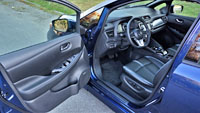
Before getting into the good, I might as well tell you about the big yellow “Warning: Malfunction See Owners Manual” alert that kept taking over the multi-information display throughout my weeklong drive, especially because the graphic included showed two cars crashing. Restarting the car seemed to reboot the system so that the warning disappeared for a time, but it kept coming back annoyingly, showing something needed attention.
That warning graphic showed up on a 7.0-inch high-resolution colour TFT display that makes up the left two-thirds of the aforementioned gauge cluster, an attractive package filled with blue, green and white eco info plus more, whereas the right-side speedometer is analogue yet circled with the same stylish aqua blue hue.
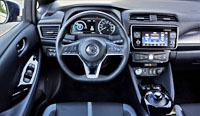
Over on the centre stack is a large 7.0-inch tablet-style touchscreen on SV and SL trims (the base audio display is 5.0 inches) complete with quick-access switchgear to each side and a couple of traditional rotating knobs that came in very handy for adjusting the audio volume and scrolling through the infotainment system’s various functions, not to mention pushing to make audio sound adjustments. The graphics are attractive, and depth of contrast quite good for having a more fingerprint-friendly matte finish, plus the system is easy to operate and responds quickly to tap, pinch and swipe gestures, the navigation mapping especially reactive and the GPS guidance very accurate. Apple CarPlay and Android Auto smartphone integration is standard, as is a smartphone app that lets owners monitor their Leaf’s charging status, schedule a future charging time, find recharging stations, pre-heat/cool the interior, and more.
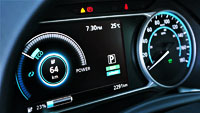
A unique bowtie-shaped single-zone automatic climate control interface sits just below in all trims, while standard two-way front seat heater switches are included within a collection of buttons that also house a 12-volt charger, USB and aux ports, and the car’s illuminated start-stop ignition button. Giving it a press brings the Leaf to life, with the only choices left being the option of default or Eco mode, and selection of the E-Pedal before releasing the electromechanical parking brake (that’s strangely not standard) and taking to the streets.
The E-Pedal is essentially the Leaf’s fourth driving mode, after default “D” for drive and “B” for increased regenerative braking, the latter two found by pulling the gear selector to the left and rearward once and then twice respectively, while Eco mode dulls response to throttle input and helps to eke out a little more range when driven economically. The new E-Pedal is more of an automated B-mode, in that it immediately applies regenerative braking when lifting off the throttle. It can be a little disconcerting at first, because it feels as if some mischievous gremlin is getting hard on the brakes without your consent, nearly bringing the Leaf to a full stop if you don’t get back on the throttle, but once familiarized it performs well and quite smoothly, while helping to recharge the battery effectively.

B-mode still exists because some owners prefer recharging their battery manually, and to that end truly skilled drivers can probably get more kinetic charging from B-mode than the E-Pedal, or at least they claim to in forums, but those new to the Leaf lifestyle might be better off leaving the E-Pedal on and Eco mode engaged when trying to extract the most from a depleting battery. Nissan claims the E-Pedal is good for 90 percent of driving requirements, with the regular brake pedal only needed for the other 10 percent, and if used this way the Leaf won’t need its brake pads replaced very often.
As long as Eco mode is turned off, throttle response is quite strong, especially when compared to conventional internal combustion engine-powered compacts. It won’t accelerate faster than a Bolt, which is a comparative pocket rocket, but it certainly won’t cause any disgruntled honking from behind.
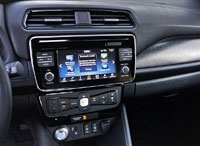
The ride is firm, this probably due to its standard Michelin Energy Saver low roll resistance tires, but it’s hardly punishing. Roughly finished inner-city streets, irregular pavement on the highway and bridge expansion joints will be immediately noticeable, but the suspension has a reasonable amount of compliance for such a small hatchback, and as noted the seats are comfortable.
The previous Leaf wasn’t exactly sporty, so I was pleasantly surprised that the new version handles quite well, at least as far as small hatchbacks go this side of a Golf GTI, while it’s nice and stable at high speeds. To get more from the battery you’ll probably want to leave it in Eco mode at speeds under 120 km/h, while I found the default Drive position better for higher speeds, as it coasts more effortlessly.
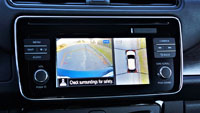
Speaking of effortless highway driving, the Leaf offers the option of Nissan’s new ProPILOT Assist semi-autonomous self-driving in SV trims and above. It combines the Leaf’s all-speed adaptive cruise control with steering assist so you can let your hands off the wheel for short durations while traveling down the highway. While I found it more of a novelty, it helps keep the Leaf centered within its lane and is kind of fun to use.
Automatic high beams are also standard on the Leaf’s two upper trims, as is Intelligent Lane Intervention, Blind Spot Warning with Rear Cross Traffic Alert, and Pedestrian Detection for the otherwise standard Automatic Emergency Braking system, while Driver Attention Alert that warns of drowsiness is standard with the SL.
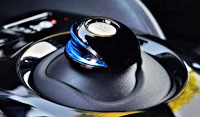
I found the automatic emergency braking system’s warning system worked very well, mostly because it didn’t flash its big orange warning very often. It only lit up when I was getting too close too fast, exactly like it should. Likewise, lane keep assist gently tugged the Leaf back into place when it started to leave its lane or I tried to nudge it into an adjacent lane that already had a car occupying it.
Now that I’ve started talking trims and features, the base Leaf S includes a generous supply of standard equipment such as the aforementioned heated steering wheel, heated front and rear seats, while the standard Leaf package also incorporates a battery heater, auto on/off LED headlamps with LED signature DRLs, proximity-sensing keyless access with pushbutton ignition, cruise control, a rearview monitor, Bluetooth phone connectivity with audio streaming, text message reading and response, four-speaker audio, satellite radio, and all the usual active and passive safety features.
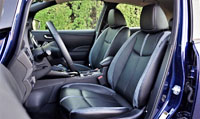
Moving up to SV trim adds the previously noted advanced driver assist systems, the electromechanical parking brake, the larger infotainment touchscreen with navigation and voice recognition, ProPILOT Assist, NissanConnect EV telematics, a hybrid heater system, 17-inch alloy wheels on 215/50 all-seasons (the base steel wheels are 16s wrapped in 205/55s), fog lamps, an auto-dimming rearview mirror, a Homelink universal garage door opener, six-speaker audio, an eight-way powered driver’s seat with powered lumbar support, and a cargo cover, while the top-tier SL gains all the extras already mentioned plus LED turn signals integrated into the side mirror housings, Nissan’s very helpful 360-degree Intelligent Around View Monitor, and the impressive seven-speaker Bose audio upgrade noted earlier.
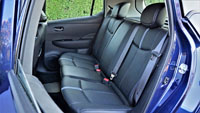
On a side note, I was glad to see a sunglasses holder in the overhead console, and yes it’s still marred by an oversized nosepiece holder that oddly doesn’t fit normal eyeglasses causing them to flop around within, but it’s better than nothing. I also appreciated LEDs used for the overhead reading lights up front. There are no rear reading lights in the rear, however, and the centre dome lamp is an old-school incandescent bulb, plus there’s no sunroof available at all, an issue that might bother some folks in need of light therapy during dark, cloudy days. Its unavailability may possibly be a weight saving issue, but when automakers are forced to compromise to such levels when going electric, it’s reasonable that some consumers just won’t go.
Yet to Nissan’s credit plenty of Canadian consumers are buying into the Leaf lifestyle, the thought of never again being gouged by greedy oil companies and greedier provincial governments too fantastical to pass up. I must admit that I’d rather plug in than pump, and as of Q3 2018 there have been exactly 10,000 Canadians that have chosen likewise.
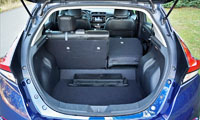
The Leaf’s popularity has grown exponentially since it launched in 2011, with its first year of sales only resulting in 170 deliveries, its second calendar year just a bit more at 240, and the following years following suit with 470 units sold in 2013, 1,085 in 2014, 1,233 in 2015, 1,375 in 2016, a dip to 946 in 2017 due to the new model changeover, and now, wait for it, 4,481 new second-generation Leafs sold in the only first nine months of 2018 (believe it or not this hodgepodge of numbers actually added up to an even 10,000).
That’s significant growth, and a great deal more per capita than Nissan’s U.S. division has achieved this year. They were only able to sell 10,686 units over the same three quarters, resulting in 2018 sales numbers that may not even reach half of the Leaf’s 2014 high of 30,200 units, showing Canadians are serious about their EVs (spurred on by much higher fuel costs. How such poor U.S. results will impact investment in the Leaf and other Nissan EVs in the future is anyone’s guess, but at the very least the Japanese brand can also take a deep bow for creating the best-selling electric car of all time, with more than 300,000 Leafs delivered globally since inception.
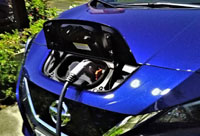
In the end, the new Leaf is hardly perfect, but it’s a considerable improvement over the quirky original and is apparently much more acceptable to Canadian EV buyers. Even considering the new Leaf’s 1.9 Le/100km city and 2.4 highway fuel economy equivalent rating, the $20k or so surcharge over a similarly sized and equipped conventionally powered compact hatchback will keep it and all other EVs in the fringe, however, especially in markets where provincial rebates aren’t offered, selling in similar numbers to performance-oriented sport compacts like the VW GTI/Type R, Subaru WRX/STI, and others.
After all, going electric requires the same level of enthusiasm and even greater financial and personal dedication than most performance car fans put into their rides, so it only makes sense for the target market to remain niche at best.

